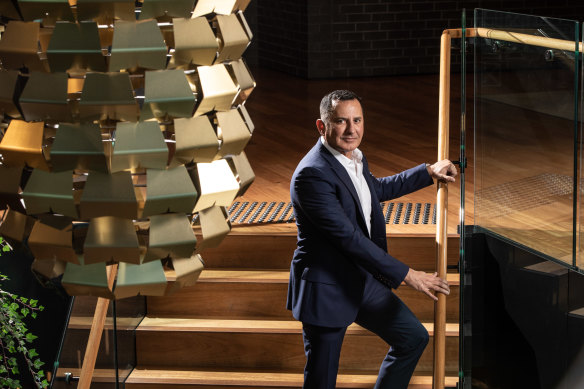
Shareholders have been patient as they watch the bank’s value crash, but they are growing increasingly jittery. Over the past decade, the ASX 200 has grown 116 per cent (both in terms of capital and dividend value), according to the analysis of respected bank analyst Brian Johnson from MST Financial.
In contrast, the banks’ value grew 102 per cent. And while the likes of Commonwealth Bank soared 174 per cent, the other big four grew by between 51 per cent and 103 per cent. BOQ’s regional rival, Bendigo and Adelaide, was up 65 per cent over that period, while BOQ tumbled 8.5 per cent.
‘George blew the doors off by dropping the rates on mortgages.’
former BoQ executive
“Management haven’t been focused on, until recently, driving return to asset commensurate with earnings and its cost of capital,” Johnson said. “Banking is a scale game and BOQ does not have scale – it’s just not profitable enough.”
A former BOQ executive who spoke on the condition of anonymity says the bank has always struggled to find and retain its identity. In the early 2000s, like many of its peers, BOQ was focused on retail banking and heavily invested in the Queensland property market, which has historically been a boom and bust.
But it concluded it needed to intensify its push to diversify its business model about two decades ago. Within 10 years, it had acquired eight businesses, including Virgin Money Australia and St Andrews Insurance.
Its next big acquisition in 2021 was of ME Bank in the hopes of growing its market share, but it came at the worst possible time, just as mortgage wars were heating up and profit margins shrinking.
“George blew the doors off by dropping the rates on mortgages, very aggressively chased growth, was successful in acquiring ME Bank, did expand business banking in the top end in syndicated loans,” the former executive said. “But between mortgage pricing to get more market share, acquisition of ME Bank and aggressively growing the business book through syndicated loans, the bank ran out of capital.”

George Frazis was dumped as Bank of Queensland chief executive just three years into the role. Credit: Paul Harris
Some of its problems, such as historical underinvestment in technology and its inadequate anti-money laundering risk controls, were self-inflicted, but others are structural. The higher cost of capital for mid-tier banks, intensifying mortgage wars between lenders, and the explosion of mortgage brokers has weighed down the Bank of Queensland.
Even the federal government has acknowledged mid-tiers are facing significant headwinds as it launched a review into the country’s small and medium-sized banks.
BOQ’s unique problem, though, is its controversial owner-managed branch network, which Allaway declared was a matter of life or death for BOQ when last month he announced the need to close them down.
The franchised network has been a poisoned chalice for the regional lender. It stopped making financial sense for BOQ as fewer Australians visited their bank branches and more moved online to do their banking, but there were also governance risks.
NSW Police in 2018 investigated a criminal syndicate that had bought outright a BOQ franchise to facilitate money laundering. The lender also faced class action lawsuits from franchisees after it moved to shut down branches, as well as from customers who lost funds after the bank allegedly failed to prevent transactions.
How will the bank convince its owner managers, some who have spent hundreds of thousands of dollars in fit-out costs, to quietly hand over the keys?
“It will be a challenge for BOQ to buy them all back. Some are highly leveraged, some are financially distressed, and many don’t want to be bought out,” the former executive says. “Quite a few are angry.”
But in an environment where Australians are starved for competition, there are questions about where BOQ fits and how it will survive. Analysts are reluctant to “predict” what the regional lender looks like in a decade, but they can see management attempting to remove all the barnacles – either to make itself more competitive to retain its identity or attractive for a takeover.
Loading
“Patrick very much has a focus on improving the profitability of the regional bank because if you very simplistically think about it as an institutional investor, why would an investor want to own BOQ?” Storey says.
“The market has been quiet patient with him. The last time we had an event with [Allaway] he said the ‘clock is ticking’. Because there is no way he can go back to the board and shareholders and say that the status quo is maintained.”
Rachel Waterhouse, chief executive of Australian Shareholders’ Association, wants BOQ executives and Allaway to know time is running out – and that patience is wearing thin.
When the bank hands down its full-year results next month, they are hoping for better answers than they have been given so far.
“It has been disappointing, and the bank has underperformed,” Waterhouse said. “Culture is what leads to performance. They need to make sure those unique aspects of the culture are right, and that they make sure the tech projects are completed.”
The Business Briefing newsletter delivers major stories, exclusive coverage and expert opinion. Sign up to get it every weekday morning.



























